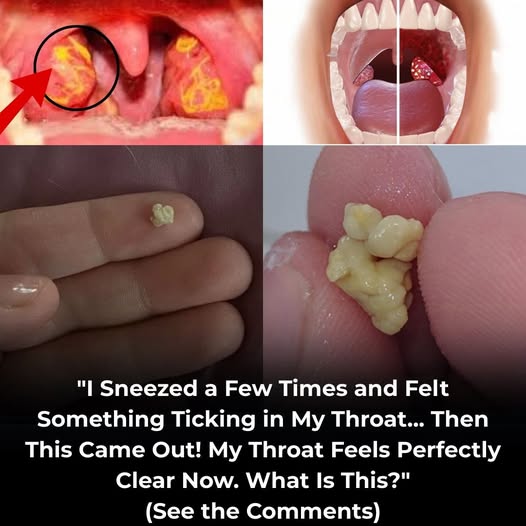Most people never think much about their tonsils—until something strange shows up at the back of their throat. You might notice a small white lump that looks like a pimple, rice grain, or popcorn kernel, sitting where it shouldn’t be. It might fall out after a cough, leaving behind a foul smell. If that sounds familiar, you’ve probably encountered a tonsil stone, medically known as a tonsillolith.
Though unsettling, tonsil stones are surprisingly common—and typically harmless. Still, they can cause discomfort, chronic bad breath, and embarrassment if not managed properly. Understanding what they are, why they form, and how to treat or prevent them can help you keep your mouth healthier and your breath fresher.
What Are Tonsil Stones, Exactly?
Tonsil stones are small, hardened formations that develop in the crypts—the tiny folds and crevices—of the tonsils. Your tonsils, located at the back of your throat, act as part of your immune defense system. They trap bacteria, food particles, and other debris to keep them from traveling deeper into your body.
Over time, this trapped material—dead cells, mucus, saliva, and leftover food—can accumulate and harden due to bacterial activity and the natural presence of calcium. The result is a small, pale lump that may feel like a foreign object lodged in your throat. While some stones are barely visible, others can grow larger than a pea.
Tonsil stones are typically soft or crumbly when fresh, but they can calcify and harden with time. Their most distinctive feature, however, isn’t their appearance—it’s their odor.
Why Tonsil Stones Smell So Bad
Even a tiny tonsil stone can smell awful. This happens because of anaerobic bacteria, the kind that thrives without oxygen. These bacteria feed on the trapped debris and release volatile sulfur compounds (VSCs) as a byproduct. These same compounds—hydrogen sulfide, methyl mercaptan, and dimethyl sulfide—are also responsible for chronic halitosis (bad breath).
This explains why brushing and mouthwash often can’t fully eliminate the odor—because the source isn’t on your teeth or tongue, but buried deeper in the tonsils.
Common Symptoms of Tonsil Stones
Small tonsil stones may go completely unnoticed and cause no symptoms at all. But when they grow larger or occur frequently, you might experience:
- Chronic bad breath (even after brushing and rinsing)
- A metallic or foul taste in the mouth
- A sore throat or scratchy sensation when swallowing
- Ear pain or fullness, caused by shared nerve pathways
- A persistent feeling of something stuck in the throat
- Visible white or yellow spots on the tonsils
Occasionally, people cough or sneeze out a stone without realizing what it is—until they notice the unpleasant odor or gritty texture.
Who Gets Tonsil Stones—and Why
Not everyone is prone to tonsil stones. Several factors can increase your likelihood of developing them, including:
- Deep tonsil crypts: Naturally deeper folds trap more debris.
- Chronic tonsillitis or inflammation: Enlarged or damaged tonsils create more crevices.
- Poor oral hygiene: Food particles and bacteria build up more easily.
- Post-nasal drip: Mucus drainage can collect in the tonsil pockets.
- Mouth breathing or dry mouth: Reduced saliva flow allows bacteria to flourish.
Teens and young adults tend to experience tonsil stones more often, likely due to higher tonsil activity and changes in oral bacteria balance. However, anyone can develop them at any age.
Are Tonsil Stones Dangerous?
In most cases, tonsil stones are harmless. They’re more of an annoyance than a health threat. That said, untreated or very large stones can occasionally lead to secondary infections, tonsil swelling, or difficulty swallowing.
The main concern for most people is social—chronic bad breath or discomfort that affects confidence and communication.
Safe Ways to Remove Tonsil Stones at Home
If you notice a visible tonsil stone and it isn’t causing severe pain or infection, there are gentle ways to dislodge it yourself:
- Gargle with warm salt water.
Mix half a teaspoon of salt into a glass of warm water and gargle deeply. The salt helps reduce inflammation and can loosen stones naturally. - Use a low-pressure water flosser.
Aim a gentle stream of water at the tonsil area to flush out debris. Avoid high settings that could cause bleeding. - Try a clean cotton swab.
If a stone is visible near the surface, gently press around it until it pops free. Do not use sharp or metal tools. - Maintain calm and patience.
Sometimes, stones dislodge on their own after a few days of gargling and hydration.
If the stone is deep, large, or painful—or if you experience bleeding, fever, or swelling—see a doctor or ENT specialist.
When to Seek Professional Treatment
For people with chronic or recurrent tonsil stones, or those whose symptoms significantly affect quality of life, medical treatment may be the best route. Common options include:
- Antibiotics – To control bacterial overgrowth, though they don’t prevent recurrence.
- Laser cryptolysis – A minimally invasive procedure that smooths the tonsil surface to eliminate crevices where debris can lodge.
- Coblation cryptolysis – Uses radiofrequency energy to achieve similar results with minimal discomfort.
- Tonsillectomy – Surgical removal of the tonsils, typically reserved for severe, persistent cases.
While surgery guarantees prevention, it’s considered a last resort due to the recovery time and potential complications.
Prevention: The Best Long-Term Solution
Even if you’ve removed tonsil stones successfully, preventing them from returning is key. Daily habits make the biggest difference:
- Brush and floss thoroughly to remove trapped food particles.
- Clean your tongue with a scraper or soft toothbrush to reduce bacteria.
- Use an alcohol-free mouthwash to avoid drying out your mouth.
- Stay hydrated—a moist mouth discourages bacterial buildup.
- Manage post-nasal drip by treating allergies or sinus infections.
- Avoid smoking and excessive caffeine, both of which dry the mouth.
These small adjustments can dramatically reduce the recurrence of tonsil stones and improve overall oral health.
Understanding Your Own Tonsils
Everyone’s tonsil anatomy is different. Some people have smooth, shallow tonsils that rarely trap debris. Others naturally have deeper pockets that tend to collect material. If you fall into the latter category, routine self-checks and consistent hygiene will make the biggest impact.
If you experience frequent sore throats, persistent bad breath, or repeated tonsil stones, discuss your options with an ENT specialist. A professional evaluation can confirm whether minor treatment or surgical correction is appropriate.
Final Thoughts: Small Stones, Big Lessons
Tonsil stones might be tiny, but they serve as a reminder of how interconnected oral health truly is. What starts as a buildup of microscopic debris can quickly become a source of discomfort, odor, and stress.
The good news? Prevention and care are entirely within reach. With mindful hygiene, gentle cleaning habits, and an understanding of your body’s signals, you can keep tonsil stones under control—or avoid them entirely.
At the end of the day, these small calcified clusters aren’t a mystery or a medical emergency. They’re simply your body’s way of asking for a little extra attention.
Your mouth—and your confidence—will thank you for it.


